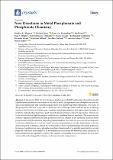Files in this item
New directions in metal phosphonate and phosphinate chemistry
Item metadata
| dc.contributor.author | Shearan, Stephen J.I. | |
| dc.contributor.author | Stock, Norbert | |
| dc.contributor.author | Emmerling, Franziska | |
| dc.contributor.author | Demel, Jan | |
| dc.contributor.author | Wright, Paul A. | |
| dc.contributor.author | Demadis, Konstantinos D. | |
| dc.contributor.author | Vassaki, Maria | |
| dc.contributor.author | Costantino, Ferdinando | |
| dc.contributor.author | Vivani, Riccardo | |
| dc.contributor.author | Sallard, Sébastien | |
| dc.contributor.author | Ruiz Salcedo, Inés | |
| dc.contributor.author | Cabeza, Aurelio | |
| dc.contributor.author | Taddei, Marco | |
| dc.date.accessioned | 2019-05-27T10:30:05Z | |
| dc.date.available | 2019-05-27T10:30:05Z | |
| dc.date.issued | 2019-05-24 | |
| dc.identifier.citation | Shearan , S J I , Stock , N , Emmerling , F , Demel , J , Wright , P A , Demadis , K D , Vassaki , M , Costantino , F , Vivani , R , Sallard , S , Ruiz Salcedo , I , Cabeza , A & Taddei , M 2019 , ' New directions in metal phosphonate and phosphinate chemistry ' , Crystals , vol. 9 , no. 5 , 270 . https://doi.org/10.3390/cryst9050270 | en |
| dc.identifier.issn | 2073-4352 | |
| dc.identifier.other | PURE: 259098197 | |
| dc.identifier.other | PURE UUID: 32eb210f-5834-432a-97d0-436b003dd47d | |
| dc.identifier.other | Bibtex: urn:6be475dd15e04889d8bbb874ff507c1e | |
| dc.identifier.other | Scopus: 85067818949 | |
| dc.identifier.other | WOS: 000472674400046 | |
| dc.identifier.other | ORCID: /0000-0002-4243-9957/work/62668312 | |
| dc.identifier.uri | https://hdl.handle.net/10023/17764 | |
| dc.description | M.T is supported by funding from the European Union’s Horizon 2020 research and innovation program under the Marie Skłodowska-Curie grant agreement No 663830. | en |
| dc.description.abstract | In September 2018, the First European Workshop on Metal Phosphonates Chemistry brought together some prominent researchers in the field of metal phosphonates and phosphinates with the aim of discussing past and current research efforts and identifying future directions. The scope of this perspective article is to provide a critical overview of the topics discussed during the workshop, which are divided into two main areas: synthesis and characterisation, and applications. In terms of synthetic methods, there has been a push towards cleaner and more efficient approaches. This has led to the introduction of high-throughput synthesis and mechanochemical synthesis. The recent success of metal–organic frameworks has also promoted renewed interest in the synthesis of porous metal phosphonates and phosphinates. Regarding characterisation, the main advances are the development of electron diffraction as a tool for crystal structure determination and the deployment of in situ characterisation techniques, which have allowed for a better understanding of reaction pathways. In terms of applications, metal phosphonates have been found to be suitable materials for several purposes: they have been employed as heterogeneous catalysts for the synthesis of fine chemicals, as solid sorbents for gas separation, notably CO2 capture, as materials for electrochemical devices, such as fuel cells and rechargeable batteries, and as matrices for drug delivery. | |
| dc.language.iso | eng | |
| dc.relation.ispartof | Crystals | en |
| dc.rights | Copyright ©2019 by the authors. Licensee MDPI, Basel, Switzerland. This is an open access article distributed under the Creative Commons Attribution License which permits unrestricted use, distribution, and reproduction in any medium, provided the original work is properly cited (CC BY 4.0). | en |
| dc.subject | Metal phosphonates and phosphinates | en |
| dc.subject | Layered materials | en |
| dc.subject | Metal–organic frameworks | en |
| dc.subject | Synthesis | en |
| dc.subject | X-ray and electron diffraction | en |
| dc.subject | In situ characterisation | en |
| dc.subject | Heterogenous catalysis | en |
| dc.subject | Gas sorption/separation | en |
| dc.subject | Proton conduction | en |
| dc.subject | Rechargeable batteries | en |
| dc.subject | Drug delivery | en |
| dc.subject | QD Chemistry | en |
| dc.subject | T-NDAS | en |
| dc.subject.lcc | QD | en |
| dc.title | New directions in metal phosphonate and phosphinate chemistry | en |
| dc.type | Journal article | en |
| dc.description.version | Publisher PDF | en |
| dc.contributor.institution | University of St Andrews. School of Chemistry | en |
| dc.contributor.institution | University of St Andrews. EaSTCHEM | en |
| dc.identifier.doi | https://doi.org/10.3390/cryst9050270 | |
| dc.description.status | Peer reviewed | en |
This item appears in the following Collection(s)
Items in the St Andrews Research Repository are protected by copyright, with all rights reserved, unless otherwise indicated.

